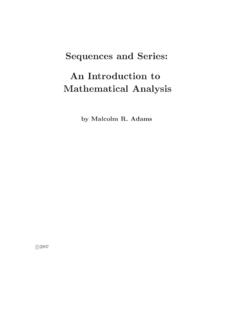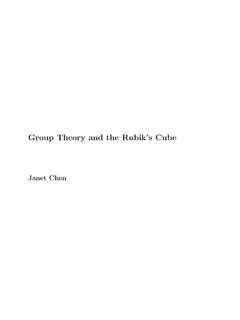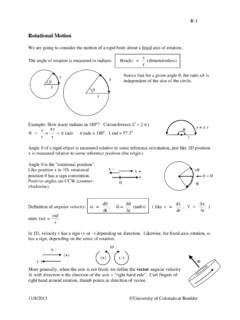Transcription of Lie algebras
1 Lie algebrasShlomo SternbergApril 23, 20042 Contents1 The Campbell Baker Hausdorff The problem.. The geometric version of the CBH formula.. The Maurer-Cartan equations.. Proof of CBH from Maurer-Cartan.. The differential of the exponential and its inverse.. The averaging method.. The Euler MacLaurin Formula.. The universal enveloping algebra.. Tensor product of vector spaces.. The tensor product of two algebras .. The tensor algebra of a vector space.. Construction of the universal enveloping algebra.. Extension of a Lie algebra homomorphism to its universalenveloping algebra.. Universal enveloping algebra of a direct sum.. Bialgebra structure.. The Poincar e-Birkhoff-Witt theorem .. Primitives.. Free Lie algebras .. Magmas and free magmas on a set .. The Free Lie AlgebraLX.. The free associative algebra Ass(X).. Algebraic proof of CBH and explicit formulas.
2 Abstract version of CBH and its algebraic proof.. Explicit formula for CBH.. 322sl(2)and its Low dimensional Lie algebras .. (2) and its irreducible representations.. The Casimir element.. (2) is simple.. Complete reducibility.. The Weyl group.. 4234 CONTENTS3 The classical simple Graded simplicity.. (n+ 1) .. The orthogonal algebras .. The symplectic algebras .. The root structures.. (n+ 1).. (2n),n 2.. (2n), n 3.. (2n+ 1)n 2.. Diagrammatic presentation.. Low dimensional coincidences.. Extended diagrams.. 584 Engel s theorem .. Solvable Lie algebras .. Linear algebra .. Cartan s criterion.. Radical.. The Killing form.. Complete reducibility.. 695 Conjugacy of Cartan Derivations.. Cartan subalgebras.. Solvable case.. Toral subalgebras and Cartan subalgebras.. Roots.. Bases.. Weyl chambers.. Length.
3 Conjugacy of Borel subalgebras .. 896 The simple finite dimensional Simple Lie algebras and irreducible root systems.. The maximal root and the minimal root.. Graphs.. Perron-Frobenius.. Classification of the irreducible .. Classification of the irreducible root systems.. The classification of the possible simple Lie algebras .. 109 CONTENTS57 Cyclic highest weight Verma modules.. When is dim Irr( )< ? .. The value of the Casimir.. The Weyl character formula.. The Weyl dimension formula.. The Kostant multiplicity formula.. Steinberg s formula.. The Freudenthal - de Vries formula.. Fundamental representations.. Equal rank subgroups.. 1338 Serre s The Serre relations.. The first five relations.. Proof of Serre s theorem .. The existence of the exceptional root systems.. 1449 Clifford algebras and spin Definition and basic properties .. Definition.
4 Gradation.. pas aC(p) module.. Chevalley s linear identification ofC(p) with p.. The canonical antiautomorphism.. Commutator by an element ofp.. Commutator by an element of 2p.. Orthogonal action of a Lie algebra.. Expression for in terms of dual bases.. The adjoint action of a reductive Lie algebra.. The spin representations.. The even dimensional case.. The odd dimensional case.. Spin ad andV .. 15910 The Kostant Dirac Antisymmetric trilinear forms.. Jacobi and Clifford.. Orthogonal extension of a Lie algebra.. The value of [v2+ (Casr)]0.. Kostant s Dirac Operator.. Eigenvalues of the Dirac operator.. The geometric index theorem .. The index of equivariant Fredholm maps.. Induced representations and Bott s theorem .. Landweber s index theorem .. 1806 CONTENTS11 The center ofU(g). The Harish-Chandra isomorphism.. Statement .. Example ofsl(2).. Using Verma modules to prove that H:Z(g) U(h)W.
5 Outline of proof of bijectivity.. Restriction fromS(g )gtoS(h )W.. FromS(g)gtoS(h)W.. Completion of the proof.. Chevalley s theorem .. Transcendence degrees.. Symmetric polynomials.. Fixed fields.. Invariants of finite groups.. The Hilbert basis theorem .. Proof of Chevalley s theorem .. 196 Chapter 1 The Campbell BakerHausdorff The the power series:expX= 1 +X+12X2+13!X3+ ,log(1 +X) =X 12X2+13X3+ .We want to study these series in a ring where convergence makes sense; for ex-ample in the ring ofn nmatrices. The exponential series converges everywhere,and the series for the logarithm converges in a small enough neighborhood ofthe origin. Of course,log(expX) =X; exp(log(1 +X)) = 1 +Xwhere these series converge, or as formal power particular, ifAandBare two elements which are close enough to 0 wecan study the convergent serieslog[(expA)(expB)]which will yield an elementCsuch that expC= (expA)(expB).
6 The problemis thatAandBneed not commute. For example, if we retain only the linearand constant terms in the series we findlog[(1 +A+ )(1 +B+ )] = log(1 +A+B+ ) =A+B+ .On the other hand, if we go out to terms second order, the non-commutativitybegins to enter:log[(1 +A+12A2+ )(1 +B+12B2+ )] =78 CHAPTER 1. THE CAMPBELL BAKER HAUSDORFF FORMULAA+B+12A2+AB+12B2 12(A+B+ )2=A+B+12[A,B] + where[A,B] :=AB BA( )is thecommutatorofAandB, also known as theLie the terms of degree three we get, after some computation,112(A2B+AB2+B2A+BA2 2 ABA 2 BAB])=112[A,[A,B]]+112[B,[B,A]].This suggests that the series for log[(expA)(expB)] can be expressed entirelyin terms of successive Lie brackets ofAandB. This is so, and is the content ofthe Campbell-Baker-Hausdorff of the important consequences of the mere existence of this formula isthe following. Suppose thatgis the Lie algebra of a Lie groupG. Then thelocalstructure ofGnear the identity, the rule for the product of two elements ofGsufficiently closed to the identity is determined by its Lie algebrag.
7 Indeed,the exponential map is locally a diffeomorphism from a neighborhood of theorigin ingonto a neighborhoodWof the identity, and ifU Wis a (possiblysmaller) neighborhood of the identity such thatU U W, the the product ofa= exp andb= exp , witha Uandb Uis then completely expressed interms of successive Lie brackets of and .We will give two proofs of this important theorem . One will be geometric -the explicit formula for the series for log[(expA)(expB)] will involve integration,and so makes sense over the real or complex numbers. We will derive the formulafrom the Maurer-Cartan equations which we will explain in the course of ourdiscussion. Our second version will be more algebraic. It will involve such ideasas the universal enveloping algebra, comultiplication and the Poincar e-Birkhoff-Witt theorem . In both proofs, many of the key ideas are at least as importantas the theorem The geometric version of the CBH state this formula we introduce some notation.
8 Let adAdenote the operationof bracketing on the left byA, soadA(B) := [A,B].Define the function by (z) =zlogzz 1which is defined as a convergent power series around the pointz= 1 so (1 +u) = (1 +u)log(1 +u)u= (1 +u)(1 u2+u23+ ) = 1 +u2 u26+ . THE GEOMETRIC VERSION OF THE CBH fact, we will also take this as adefinitionof the formal power series for interms ofu. The Campbell-Baker-Hausdorff formula says thatlog((expA)(expB)) =A+ 10 ((exp adA)(exptadB))Bdt.( ) The formula says that we are to substituteu= (exp adA)(exptadB) 1into the definition of , apply this operator to the elementBand then carrying out this computation we can ignore all terms in the expansion of in terms of adAand adBwhere a factor of adBoccurs on the right, since(adB)B= 0. For example, to obtain the expansion through terms of degreethree in the Campbell-Baker-Hausdorff formula, we need only retain quadraticand lower order terms inu, and sou= adA+12(adA)2+tadB+t22(adB)2+ u2= (adA)2+t(adB)(adA) + 10(1 +u2 u26)dt= 1 +12adA+112(adA)2 112(adB)(adA) + ,where the dots indicate either higher order terms or terms with adBoccurringon the right.
9 So up through degree three ( ) giveslog(expA)(expB) =A+B+12[A,B] +112[A,[A,B]] 112[B,[A,B]] + agreeing with our preceding The meaning of the exponential function on the left hand side of theCampbell-Baker-Hausdorff formula differs from its meaning on the right. Onthe right hand side, exponentiation takes place in the algebra of endomorphismsof the ring in question. In fact, we will want to make a fundamental reinter-pretation of the formula. We want to think ofA,B, etc. as elements of a Liealgebra,g. Then the exponentiations on the right hand side of ( ) are stilltaking place in End(g). On the other hand, ifgis the Lie algebra of a Lie groupG, then there is an exponential map: exp:g G, and this is what is meant bythe exponentials on the left of ( ). This exponential map is a diffeomorphismon some neighborhood of the origin ing, and its inverse, log, is defined in someneighborhood of the identity inG. This is the meaning we will attach to thelogarithm occurring on the left in ( ).
10 3. The most crucial consequence of the Campbell-Baker-Hausdorff formulais that it shows that the local structure of the Lie groupG(the multiplicationlaw for elements near the identity) is completely determined by its Lie For example, we see from the right hand side of ( ) that group multi-plication and group inverse are analytic if we use exponential 1. THE CAMPBELL BAKER HAUSDORFF FORMULA5. Consider the function defined by (w) :=w1 e w.( )This is a familiar function from analysis, as it enters into the Euler-Maclaurinformula, see below. (It is the exponential generating function of ( 1)kbkwherethebkare the Bernoulli numbers.) Then (z) = (logz).6. The formula is named after three mathematicians, Campbell, Baker, andHausdorff. But this is a misnomer. Substantially earlier than the works of anyof these three, there appeared a paper by Friedrich Schur, Neue Begruendungder Theorie der endlichen Transformationsgruppen, Mathematische Annalen35(1890), 161-197.











